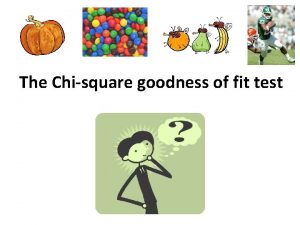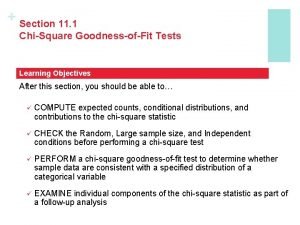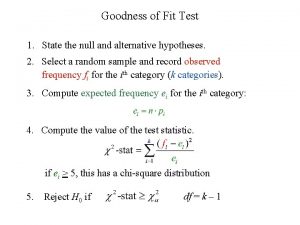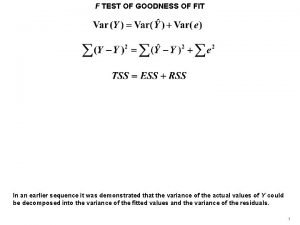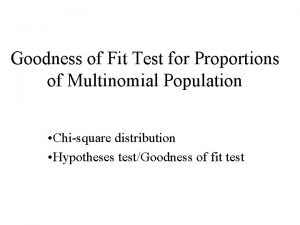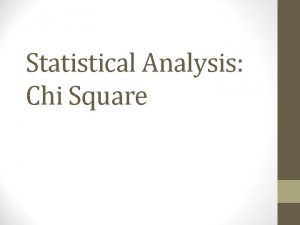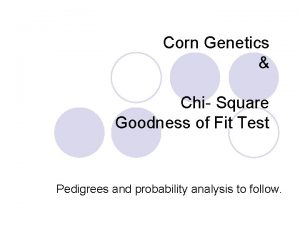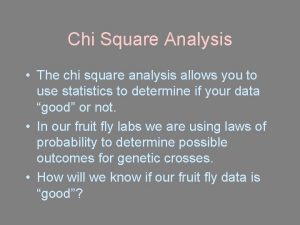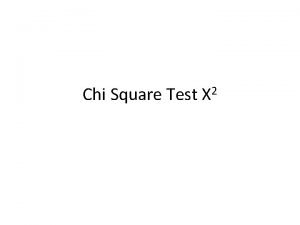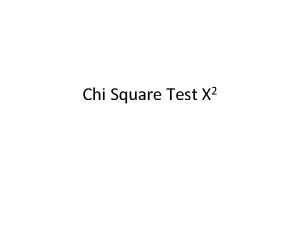Statistical Analysis Chi Square Goodness of Fit Test











- Slides: 11

Statistical Analysis: Chi Square

“Goodness of Fit Test” Chi Square (χ2) • Statistical analysis used to determine whether data obtained experimentally is significantly different to the expected data • Used to determine if any deviations from the expected results are due to random chance alone or to other circumstances

Chi Square (χ2) • Use the equation to test the “null” hypothesis • Do this for each of the categories

Chi Square (χ2) • Once you have calculated the value of χ2, you must determine the probability that the difference between the observed and expected values (χ2) occurred simply by chance (sample error) • You compare the calculated value to the appropriate value in a “degrees of freedom” table

Degrees of Freedom • Degrees of freedom = # of categories – 1: If there are 2 categories there will be 1 degree of freedom • Takes into account the natural increase in χ2 as the number of categories increases df 1 2 3 4 5 6 7 P = 0. 05 P = 0. 01 P = 0. 001 3. 84 5. 99 7. 82 9. 49 11. 07 12. 59 14. 07 6. 64 9. 21 11. 35 13. 28 15. 09 16. 81 18. 48 10. 83 13. 82 16. 27 18. 47 20. 52 22. 46 24. 32

Null Hypothesis- Ho • (in a statistical test) the hypothesis that there is no significant statistical difference between specified populations • any observed difference being due to sampling or experimental error.

Why subtract 1? • The degrees of freedom are the number of values that are free to vary in the data set. For example: • Q. Pick three numbers that have a mean (average) of 10. A. Some sets of numbers you might pick: 9, 10, 11 or 8, 10, 12 or 5, 10, 15. Once you have chosen the first two numbers in the set, the third is fixed. In other words, you can’t choose third item in the set. The only numbers that are free to vary are the first two. So degrees of freedom for a set of three numbers is TWO.

AP Chi Square Problems • Calculate the Expected by taking the total and dividing by the number of categories or by doing a Punnett square and using the percentages • Use the Chi Square equation • Determine the degrees of freedom • Look up the Critical value at the 0. 05 level • REREAD the question before you answer your short answer.

Practice Problem 1 A heterozygous white-fruited squash plant is crossed with a yellow-fruited plant, yielding 200 seeds. Of these, 110 produce white-fruited plants while only 90 produce yellow-fruited plants. Are these results statistically significant? Explain using chi square analysis

Solution to Problem 1 Calculate the expected by using a punnett square: W w w Ww ww Expected results: 50 % white 200 x. 5= 100 50% yellow 200 x. 5 = 100

Chi Square Equation Now calculate the observed using the formula: (110 -100)2 + (90 -100)2 100 2= 1 + 1 = 2 Degrees of freedom = 2 -1 = 1 Critical Value on the table = 3. 8 So do we accept or reject the H 0 ? Are these results statistically significant?
 Chi square test goodness of fit
Chi square test goodness of fit Chi square goodness of fit p value
Chi square goodness of fit p value Casinos are required to verify that their games
Casinos are required to verify that their games Chi square goodness of fit p value
Chi square goodness of fit p value Memory allocation policy
Memory allocation policy Goodness of fit test
Goodness of fit test F test statistic formula
F test statistic formula Goodness of fit test ti 83
Goodness of fit test ti 83 First fit allocation
First fit allocation Macam macam uji goodness of fit
Macam macam uji goodness of fit Multinomial goodness of fit
Multinomial goodness of fit Goodness of fit adalah
Goodness of fit adalah
